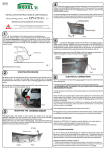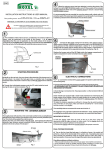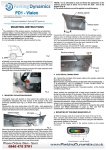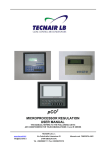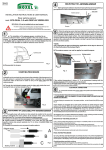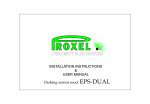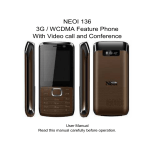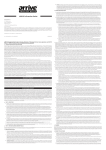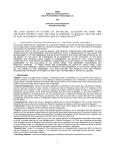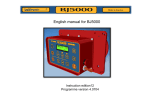Download MOUNTING INSTRUCTIONS
Transcript
NOTE: 1) It is advisable to start and finish the application of the antenna sensor tape et about 15 cm from the both end of the bumper (Fig. 4). 2) The sensor antenna can not be applied on metal bumpers. Sticking material INSTALLATION INSTRUCTIONS & USER MANUAL Parking sensor mod. EPS-DUAL FRONT The system is strictly a driver assistance device and should not be relied upon as a security device or a substitute for safe driving practices. Use common sense when reversing and always follow recommended safe driving guide Antenna sensor MOUNTING INSTRUCTIONS 1. The installation of the antenna sensor, constituted by an aluminium adhesive ribbon, must be performed to the inside of the bumper. It is of some importance that the zone of application on the inside surface of the bumper corresponds to the higher part as regards the ground and the more protruding. . It is not advisable to install the antenna sensor too low unless you want to have a good protection of the front spoiler. . Correct zone 15cm Fig. 4 Connect the RF Cable coming from the ECU to the antenna sensor. Apply a piece of sticking material on the connection and fix it on the bumper by a strong pressure (If the ambient temperature is below 10 °C we recommend heating both the mastic and the sticking area on the bumper). It is necessary to use the same material to fix the opposite extremity of the antenna. (Fig. 5). Replace the bumper and pull the RF Cable inside the luggage compartment or engine compartment in order not to leave excess cable outside. Sticking material Fig. 1 2. STARTING PROCEDURE A) Locate a passage where, from the outside at the extremity of the bumper, it is possible to route the RF cable through the engine compartment to the driver's place behind the dashboard. RF Cable Fig. 5 B)Through the individuated passages route the RF cable from the dashboard leaving the fast on outside. (Fig. 2) 4. ELECTRICAL CONNECTIONS A) The central unit has to be fitted on the inside of the vehicle under the dash board in the more convenient place where the RF Cable has been routed. B) Connect the black wires of the harness to the negative pole and the red to a 12 Volt subkey through the push-button activation, (the system is so activated pressing the button). RF cable Fig. 2 3. MOUNTING THE ANTENNA SENSOR C) Connect the twin wires black cable of the harness to speaker placed in any place where you can easily hear it. D) Insert all plug-in connectors into the proper position on the Central Unit (ECU) as per Fig. 6. Thoroughly clean with alcohol or nitro solvent (be careful not to use antiadhesive detergent) the inner surface of the bumper of the zone previously identified (see Fig.1) on which will be applied the antenna sensor. Starting from the zone where there is the RF cable , start applying the adhesive aluminum tape (antenna sensor) practising a good pressure to make it well adhere to the inner surface of the bumper *. Antenna sensor RF Cable Some vehicles are equipped with a metal crash protection bar insert facing the inside surface of the bumper. When this metal surface is too close to the inner surface of the bumper where you have placed the antenna sensor, the distance signal can be reduced . The sensibility that we recommend for most cars is the No. 2. We suggest to carry out tests to determine the detection range, pointing out that increasing the sensibility where it is not necessary, can cause more false alerts. To adjust the distance signaling is sufficient to change the dip-switch positions (see Block Schematic on page 2). Take care that the sensitivity No 1 is the lowest and the number 4 is the largest. Inside bumper surface Fig. 3 5. MOUNTING THE SPEAKER When the antenna sensor has been attached, covering the whole of the a) Mount the PD1-FRONT speaker using its adhesive in a proper place bumper from left to right, the excess length is cut off. Place a piece of the in order to ensure a good perception of sound by the driver. included sticking material at either ends of the antenna sensor to ensure a secure fixing onto the bumper surface. It is recommended (but not b) Connect the buzzer cable to the buzzer through its plug-in connector. essential) to cover the antenna with a black anti-rust protection paint of the same type that is applied to the underneath of a car chassis or similar to protect from the elements (do not use silicon paste). 6. FINAL TESTING PROCEDURE A) Turn on the key, press the push-button. In a fraction of second the WARNING control unit performs a check of the functionality of the system and, if everything has been done correctly, the transducer emits an acoustic 1. In presence of rain or high moisture weather, the system sound of "OK" (one note). Once you have this signal the system becomes reduces his sensibility automatically in order to eliminate a part of operational. Possible problems and their solutions 1. If the acoustic transducer does not emit any signal check all the connections. 2. If the transducer emits an audible warning signal consisting of 2 notes (one high and one low) repeated 3 times) check the connection of RF cable. false alarms that could be given by movement of water on the bumper. 2. As soon as the system is activated an acknowledgment of the surrounding of the bumper is made. Consequently it is quite important, during testing operation, not to switch on the system while you are very close to the antenna sensor in order not to have false information on the working B) Starting from about 1 metre away from the centre of the bumper, slowly capability of the system. approach both hands to simulate a parking manouevre. At a distance of about 30/40 cm will be heard the first intermittent signals and then a continuos higher frequency sound at about 10-15 cm from the bumper. ALARM SIGNAL RISK OF CONTACT SIGNAL WARNING: The PD1-FRONT must be switched off when driving in order not to be cause of useless warnings. C) If the system shows to work regularly it is possible to fix definitely the bumper. NOTE: PD1- FRONT starts to give the signalling only when the vehicle is being approached to the obstacle; a fixed object in front of the bumper, for instance the hauls hook and a bull bar or the sides walls of a car box, is not signalled and it is not bothered the normal operation of the device. USER MANUAL Fig. 6 (OPERATING PRINCIPLE) PD1-FRONT is an innovative parking sensor that uses low energy electromagnetic waves and is able to detect the approach of any kind of obstacle . The activation of the device is Switch position (white color) - Antenna sensor Sensibility 1 obtained by pressing the activation button and confirmed by a signal of “OK". Once activated, the PD1-FRONT generates around the bumper, on which is installed, a protection zone (Fig. 6). When any obstacle present in the protection zone tends to approach the bumper you will hear a series of beeps. Central module (ECU) Sensibility 2 1 2 WORKING EXAMPLE Sensibility 3 A) As soon as the PD1-FRONT is activated the control functionality of the system is carried out in a fraction os second. In case of anomalies the speaker emits an audible warning signal consisting of 2 notes (one high and one low) repeated 3 times. If this happens check the antenna connection to the ECU. If the control is OK you hear a signal of a single note to confirm the proper functioning of the system. B) When approaching an obstacle the system activates the acoustic signal at a distance between the bumper and obstacle (measured in the central area of the bumper) of about 30/40 cm with 2 types of sounds: 1) an increase in sequence of "BIP" (alert) when the obstacle To push-button switch Buzzer Sensibility 4 Block schematic TECHNICAL CHARACTERISTICS - Operating range from 9,5 to 18V - Operating temperature from -20 to +90 °C - Max current absorption 70 mA - Max. distance to begin detection 50-60 cm comes close to the bumper at a distance between 15 and 40 cm measured on the middle of bumper and in function of the choosed sensibility. 2) a continuous sound at a more low frequency (risk of contact) when an obstacle is very close to the bumper (10-15 cm). Buzzer Cable Push button NOTE: RF Cable Buzzer Power Cable - The device should be activated only during parking maneuvers. - The distances will vary depending on the size of the obstacle and correspond to the central zone of the bumper; on the lateral edges the distances is less (see Figure 6) - The alert occurs only when the vehicle is approaching an obstacle, a fixed object in front of the bumper is only detected after the first movement of approach. Sticking material Antenna sensor Central unit +


